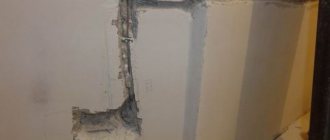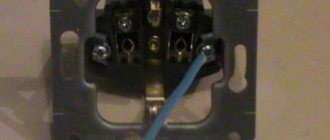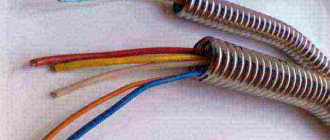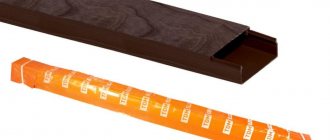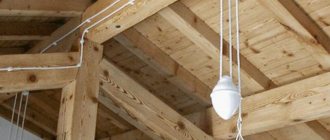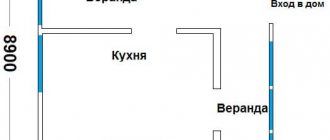Sometimes a house needs to replace old electrical wiring or increase the number of sockets, lighting fixtures, and so on. To prevent wires from passing along the surface of the wall, spoiling the appearance, a gating procedure is carried out. Work on cutting grooves is carried out during major and cosmetic repairs, when laying electrical wiring in a new building.
Standards to be followed when gating walls
The beginning of any work is drawing up a plan, and when it comes to wiring, a number of rules must also be taken into account. in advance about the location of all sockets, switches, lamps and household appliances . Mark each of the electricity consumption points on the plan. Also on the drawing it is necessary to indicate the route along which the wires will pass. You can depict all this on paper, or you can use specialized programs.
When drawing up an electrical wiring plan and determining where the grooves will go, take into account the following points regulated by SNiP 3.05.06-85
- The grooves must be strictly vertical or horizontal . This will make someone's life easier years later when searching for wiring in the wall. The only exception is gating walls with a slope, such as in the attic, then the groove must be parallel to the slope of the wall;
- maximum groove width – 30 mm, depth – 26 mm;
- the length of the route from the distribution box to the point is no more than 3 m;
- between two points only one turn of the wire is allowed, since each turn is a source of increased heating of the cable;
- the distance from the groove to the gas pipe and battery is at least 50 cm, from the door and window - at least 10 cm, from the floor and ceiling - from 5 cm;
- It is prohibited to tap internal load-bearing walls , since if the material is damaged, the reinforcement may be exposed, which will start the corrosion process, and this will certainly affect the strength of the entire building. But still there are several options for getting out of the situation - read about it below;
- Corners and floor slabs cannot be tapped. The wiring can be hidden in a concrete screed, in a cable channel.
Wall chipping is a dusty and noisy process, so be sure to wear a mask, or better yet, a respirator, as well as gloves and goggles. Carry out work from 10 to 17, taking breaks to maintain good neighborly relations.
Selection of nozzles
Basically, the crown and similar attachments are included with the equipment. The price of slotting attachments for a rotary hammer is quite high, but it is also impossible to work without them. If you buy an ordinary attachment, for example, the same crown, it can be inexpensive, but it will not last long. Of course, you can increase the service life of the nozzles, water them, for example, with water to cool them, and take frequent breaks so that they do not overheat.
But it is much more effective to use diamond drill bits, but when choosing them you need to take into account the permissible size and type of hammer drill.
Diamond bit
You also need to choose a drill for concrete. The one that comes with the equipment is generally not for heavy loads. Therefore, you need to choose a set for the job, or choose a high-quality tool that has a certificate. Not quite suitable Chinese drills for an expensive hammer drill. When choosing, you need to pay attention to the spiral - it is considered the best with a more twisted spiral. When choosing a blade, you need to look at what metal is used in it. A hardened tool will crumble and require constant sharpening.
Attachments for hammer drills for wall slitting
It is better to choose the original instrument. Analogs are not helpful in this type of work, you’ll just waste money.
A hammer drill is a more powerful and efficient device than a conventional drill. It will be able to perform all the same tasks, but also has additional capabilities. However, this goal can only be achieved with the correct selection of additional elements and accessories.
Surface marking
Preparation for gating walls is as follows:
- detect old wiring , for which testers and indicators are used. It’s good if you have a plan for the old wiring, but, as practice shows, not everyone is so lucky. The location of the old wiring must be marked on the wall;
- the old wiring needs to be disconnected, and if this is completely impossible, then the new line should not intersect with the old one;
- the new wiring route is also marked on the walls from the junction box to each connection point;
- It is better to cover doorways with a damp cloth. Even if the door leaf is closed, dust will find its way into the cracks and fill the rest of the room.
Types of nozzles for gating
Well, we got acquainted with the basic rules, the drawing and plan were drawn up. It is advisable to take a photo of the markings so that you don’t have to look for the wiring later. Now let's decide on the nozzles. Basically this is a drill and a shovel for laying cables and a crown for openings for a socket. Please note that this type of work will generate a lot of dust, so doorways should be covered tightly with a damp cloth. During work, you need to use a special construction vacuum cleaner to clean the air and room from concrete dust. An ordinary vacuum cleaner will quickly fail.
Methods for gating walls for wiring
Hammer and chisel
A hammer and chisel are old-fashioned tools that will allow you to spend a minimum of money on chiselling walls. The downside is that the grooves will be crooked, and the process itself will be very long . It’s hard to imagine using a hammer and chisel to make grooves for all the wires in an apartment.
The process itself is quite simple and can be done without much preparation. First, the wide side of the chisel is applied to the intended line and hit with a hammer. In this way, the edges of the groove are outlined. Then the chisel is placed across the groove and begins to knock out a recess in the wall. You can mark the boundaries of the groove in a certain area, and then “dig” in depth, or you can “go deeper” after every couple of centimeters of the boundaries made.
The lines of the grooves will be uneven, but subsequently they will still be hidden under a layer of plaster and finishing. You can get smoother edges if you make cuts with a hacksaw in advance.
A hammer and chisel is the longest and most labor-intensive method of chipping walls. It is suitable if suddenly there is a need to extend the existing route, but you no longer want to call a specialist with a wall chaser.
This method is useless for concrete and brick walls.
Rotary hammer or impact drill
Both tools allow you to quickly groove walls, but the edges of the grooves will be uneven. An impact drill and a hammer drill are not the same thing. An impact drill makes holes through rotation, a hammer drill makes holes through impact. In a drill, the blow is weak, but with high frequency; in a hammer drill, the blow is stronger and does not require any assistance from a person. The drill can handle concrete and brick, but is not designed for frequent impact drilling. A rotary hammer is much more powerful and can chisel concrete and brick of any density, so it is a priority for chiseling.
The operating principle is as follows:
- use a drill to make indentations at a distance of 1-1.5 cm from each other along the entire route;
- replace the drill with a blade and clean the groove at an angle of 45 degrees, moving from point to point. Use the “no drilling” mode;
- It is better not to place the hammer drill blade across the wall, otherwise you can break off a piece of the wall;
- If you only have a drill at your disposal, then take a Victory drill with a diameter of 8-10 mm. The distance between the holes is smaller - 0.5-1 cm. If you need a wide groove, make the holes in a checkerboard pattern. The gaps are knocked out using a hammer and chisel, as described above. This method is suitable if it is necessary, for example, to make grooves in one room. If the task is to carry out wiring throughout the entire apartment, then it is better to invite a specialist. Residents of Kyiv and the region can contact the Relicon company; on the page https://relicon.kiev.ua/elektromontazh/ you can find a list of services, prices and benefits. The company's specialists carry out both entire projects and individual electrical installation work.
Bulgarian
The grinder allows you to create a groove with perfectly smooth edges , without chips or cracks, so further rough finishing work will be simplified. You will need a tool with a diamond blade. Along the intended wiring route, two parallel lines are cut, the width between them corresponds to the width of the groove. You will have to remove the material from the groove using a hammer drill or a hammer and chisel.
When working, the grinder produces a lot of dust, so you can immediately suck it up with a vacuum cleaner, holding the tube close to the source of its formation. A household vacuum cleaner will not work - only a construction vacuum cleaner. You can rent it or borrow it from friends. But even with a construction vacuum cleaner you won’t be able to collect all the dust.
To minimize the formation of dust, you can constantly moisten the wall, but this must be done before starting to use the tool so that water does not get on the disk. You can also find special vacuum cleaners on sale that connect to an angle grinder - an option in case you can’t find an assistant.
Wall chaser
A wall chaser is a professional tool. There is no point in buying it for one time, but if you have the opportunity to rent it, then why not. The wall chaser is equipped with two diamond disks; you can vary the distance between them, determining the width of the groove, and you can also set the desired depth. Both circles are covered with a casing on top, which is adjacent to the wall when cutting. All dust is immediately drawn into the vacuum cleaner through the outlet provided for this purpose.
After the edges of the grooves are formed (they turn out perfectly smooth, the process itself is quick and not particularly dusty), the remaining material is removed with a puncher.
What is a hammer drill blade?
Chisel for a hammer drill – a replacement attachment for a hammer drill. Its purpose is to chisel holes and grooves in objects made of solid building materials: concrete, stone. Chipping or removing seams from mortar, knocking down tiles are tasks for a chisel. It is installed in the barrel for a hammer drill, which fails more often than other parts.
Shoulder: flat wide, flat narrow and peak
It is a long rod with one pointed end. The shape and size can be different: according to the task, type of cartridge, angle of the working surface, its width and curvature.
One side is the cutting edge. Performs work by exerting force on the surface of the material. The other side is a shank for mounting in a power tool chuck.
There are 4 main shank shapes:
- 1. sds: rare, serves as a tool for budget models;
- 2. sds plus: diameter – 10 mm, 4 grooves for fixation, serves in light models weighing up to 5 kg;
- 3. sds max: diameter – from 18 mm, the same 4 grooves, but for professional tools weighing up to 12 kg;
- 4. hex: only used for powerful attachments in instruments weighing more than 12 kg.
Features of gating of different materials
Grooves in aerated concrete and foam concrete
These are quite soft materials; a drill, an angle grinder, and a hammer drill can easily handle it. You can even use a manual wall chaser , which is equipped with a pointed arc. A groove of the required depth can be made in 3-4 approaches. If necessary, such a tool can even be made independently from rigid punched paper tape or a metal plate sharpened on one side. For convenience, attach a handle or pipe.
Grooves in wood
It is prohibited to install hidden electrical wiring in wooden houses . All cables are laid openly and can be hidden in cable ducts, so there is no need to ditch the walls.
Grooves in drywall
Drywall is too fragile a material to be chipped. All wires are laid behind it, and holes for sockets are made using a crown attachment on a drill or hammer drill.
Grooves in brick and concrete
For horizontal grooves in a brick wall, even a hammer and chisel will do if you can get into the seam, but vertical grooves are best done using a power tool - a drill, hammer drill, wall chaser.
Concrete is a durable material, so you definitely can’t do anything with a hammer and chisel, but all other methods will do. If the concrete is of high strength, then it is better not to use a grinder - the circle may break when pressed.
Grilling load-bearing walls
You should be extremely careful with internal load-bearing walls. An awkward movement - the reinforcement is exposed, and now the strength of the entire building is compromised. What should apartment owners do? There are several options:
- from the local construction department obtain permission to groove walls, trying to prove that the grooves will not be so deep and you will not reach the reinforcement frame;
- Apply a layer of plaster to the wall and only then trench the wall. The entire depth of the grooves will fall mainly on the plaster layer;
- hide the wires behind the drywall , this will also solve the problem of wall alignment;
- lay wires in electrical skirting boards. If you choose a model of the right color and design, you won’t do much harm to the aesthetics.
Hammering with a hammer drill: advantages of a hammer drill over other tools
When choosing a tool for chiselling walls, craftsmen increasingly prefer a hammer drill. This is understandable, because if even furrows are not particularly important to you, then there is no better option. So, a chisel and a hammer, if it is possible to use them at all, will take a lot of time, but will give the same result.
An angle grinder will create a lot of dust, and a wall chaser is often unaffordable. Having a hammer drill - the work is done quickly, without dusting the room. Therefore, if the evenness of the furrows is not important, you can safely take this tool and get to work, having first studied all the necessary requirements.
Preparing for work
Before you begin, you should make a plan with all the sockets and switches, as well as the paths along which the cables will go. In order to plan everything correctly, you need to know the rules for performing grooves.
When making a plan, do not forget about one important condition - you need to “bypass” the cable, which is quite likely already in the wall.
The next step, according to the previously drawn up plan, is to apply markings to the walls and ceiling.
Since we touched on processes where there is a need to use tools, let’s talk about them in more detail (especially since at the same stage we will need to prepare them).
Well, ruler pencils are self-explanatory and too simple to mention. What else should you prepare? The list of required tools looks something like this:
- detector to check the presence of a cable;
- level (by the way, laser is in fashion now);
- actually, a hammer drill;
- attachments: drill, spatula (or peak) and crown (for making recesses for rosettes).
You will also need personal protective equipment in the form of a respirator and goggles: despite the low level of dust, it is still present, and small pieces can also be found. If you need to carry out work at height (often the grooves are made under the ceiling), you need to take care of the support. You can take a stepladder, but it doesn't inspire confidence. It is better to use scaffolding - they can provide reliability.
Such know-how as construction stilts has appeared on the construction market. They provide convenience, reliability, and also do not require time to assemble and do not take up much space.
Before work, you must turn off the electricity in case the wire does get in the way.
How to punch a wall with a hammer drill? Step-by-step instructions
So, let’s imagine that we have the markings and the IZ equipment is on. Before you make a hole with a hammer drill, you need to take it with a pre-installed drill and drill holes along the intended line, retreating 1-2 centimeters each time. After the holes are ready, change the attachment to the blade, switch the hammer drill to impact mode and connect the previously drilled holes. In the case of plaster walls, you can get by with the same drill.
When performing grooves with a hammer drill, you need to hold the tool correctly so as not to place the blade across the drawn line, otherwise you can break off a piece of the wall.
Now let's move on to the sockets for the socket boxes. To perform them, you need to use crowns, and different attachments are suitable for a certain type of wall:
- with pobedite soldering (used for brick walls);
- diamond (it makes grooves in concrete walls).
First, you need to use a drill, which makes a hole in the center of the future nest. Then the diameter is recessed with a crown. In order for this attachment to go deep well, it is worth changing it back to the drill and making holes according to the diameter. After this, we put the crown back on and make a socket.
Useful video
The video shows the process of creating a hole for a socket using a hammer drill (with a crown mounted as a drill).
When making holes with a diamond crown, do not put the device in impact mode.
When the nest is ready, you need to change the crown to a spatula or drill to knock out the remaining material.
All this time you need to work in a respirator and - especially - in safety glasses. Pieces of material (especially concrete) tend to fly into the eyes, as a result of which it is very easy to get injured.
Legal side of the work
Of course, you want to lay the grooves in a way that is convenient for later laying the cable (for example, lower or closer to the corner). But many ideas can end in failure. Therefore, special rules and regulations must be observed. How to properly tap a wall for wiring with a hammer drill:
- The cable must be laid strictly vertically or horizontally (it is not allowed to lay the cable diagonally);
- Minimum clearances: 150 mm from the ceiling, 400 mm from the gas pipeline and 100 mm from windows, corners and doorways;
- Maximum depth and width: 250 mm, length: 3000 mm not on load-bearing walls or ceilings.
Listed here are only the basic conditions that ensure compliance with the standards for gating walls for wiring with a hammer drill. To be sure that the plan is correct, invite a specialist from BTI. He will tell you what is correct and what needs to be revised. If you have unauthorizedly completed the strobe in the wrong place, someone noticing this may report it to the same BTI, and then you will have to answer according to the law.
vinstrumentah.ru
How to seal a groove?
The final stage of work proceeds as follows:
- the grooves must be cleaned of dust; either a construction vacuum cleaner or an ordinary broom will do;
- grooves should be treated with a primer;
- to reduce the level of shrinkage, you can slightly wet the wall near the grooves;
- when everything is completely dry, cables and distribution boxes are installed according to the diagram;
- gypsum plaster is usually used to seal the grooves;
- To prevent the plaster layer from sagging and starting to collapse, you can use a reinforcing mesh.
Finally, let us note again. If you are not sure that you can do all the work yourself, it is better to immediately contact specialists.
The article was written for the site.
Tags:Electricity
